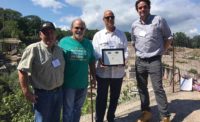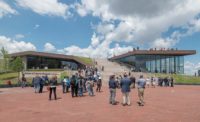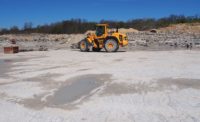Nestled on the shores of the Long Island Sound, the village of Stony Creek, CT, is quaint and rich in history. The village is built on the rocky surface of Stony Creek granite, the stone of a geological formation that crystallized 360 million years ago. Stony Creek granite is an irregular textured stone which is due in part to pegmatite, in part to flow structure (defined mainly by the black biotite) and in part to gneissic foliation.
In 1900, there were over 10 quarries that mined this attractive stone for projects across the U.S. Today, the Stony Creek quarry in Branford, CT, is the only remaining producer of Stony Creek granite. It is over 150 years old, and has supplied stone for the pedestal of the Statue of Liberty, the Smithsonian and Columbia University to name a few landmark structures. And while it treasures its historic clients, which it continues to work with, the company has evolved into a modern quarry epitomizing the values of our current society. Key to its modernity, Stony Creek Quarry is a sustainable operation – recently completing a rigorous process to receive gold-level certification for the ANSI/NSC 373 standard – to make its material a desirable product for architects who are building with the environment in mind.
Stony Creek granite is one of the oldest granites in the nation. The site operated by Stony Creek Quarry is surrounded by a land trust and owned by the town of Branford. “We have the honor of being an intimate part of the town,” said Tom Cleveland, the company’s director of sustainability. “This quarry is in the town’s DNA. One reason for doing the certification is to show the town we are good stewards of the quarry.”
According to a statement on the Natural Stone Council’s (NSC) website, the organization that worked to develop the standard, ANSI/NSC 373 “established criteria for the natural stone industry to measure the extent to which natural stone is produced sustainably. Developed by the NSC in association with Ecoform, an independent consultant, and NSF through the Natural Center for Sustainability Standards (NCSS), this standard establishes a set of well-defined environmental, ecological, social responsibility and human health requirements for stone quarries and processors.”
Stony Creek Quarry was the third quarrier to complete the certification process.
Darrell Petit, director of business development at Stony Creek Quarry, is among the leaders in the industry in the sustainability movement, explained Cleveland. “As one of the smaller corporate organizations supporting [the standard], it was a way to distinguish the quarry,” he said.
According to Petit, who was a part of the sub-committee that worked to develop the standard, there was a lagging response to a global challenge when it came to standards for the stone industry. “We felt as an industry, we were not up to speed,” he said. “From Stony Creek’s perspective, we wanted to be a part of an inevitable revolution and help the stone industry evolve.”
“Darrell has marketed Stony Creek granite directly to architects for over 20 years,” said Cleveland. “He continues to see a real interest among architects for a sustainable granite material. The question of sustainability is becoming as important as aesthetics or other physical characteristics [of the granite].”
Petit explained, “Architects who are working on municipal and institutional projects are especially interested in finding sustainable natural stone materials. “When we first got the NSC 373 certification, I started to get calls and emails from architectural firms we had never spoken to before,” he said. “These were new opportunities, as well as a new level of visibility and respect.”
Petit added that it “became apparent that we couldn’t talk about [our product] without a sustainable mission. In a presentation, you really have to make a primary point in educating them where you stand on the sustainability front. This is where it comes down to looking at materials when writing a spec. They come back to us to help write the spec. It further clarifies our position. Architects are coming to us more and more. Why shouldn’t they reach out to the operation who is the origin of the material? It’s not only vital, but becomes a valuable education.”
The certification process
Stony Creek Quarry began round one of the certification process in 2016, and it took approximately a year to complete. “We worked closely with the Yale School of Forestry,” said Petit. “They helped by sending us an intern. [Also], any challenges at that point were offset by other industry leaders. Brenda Edwards [of TexaStone Quarries] and John Mattke [of Coldspring] helped us with any questions. The NSC was also very helpful to get us through it.”
Petit went on to say it was not too difficult. “It was assessing what we had in place and putting a program together,” he said. “We looked at the operation with eyes of sustainability. It’s a valuable process. We looked and asked, ‘Do we really have to do this?’ ‘Should we do something in a different way to save energy and water?’ You always want to continually set goals for your operation and evaluate it.”
Petit also emphasized it is a continual process. “I think a lot of people who are certified that we have spoken to now find ways to evolve,” he said. “They’re constantly trying to improve. There is no point to getting certified and then staying static. Tom is now making inroads into our management. He’s getting into more details to improve.”
According to Cleveland, one point that keeps resurfacing time and time again is that every quarry has quarrying processes that are very specific to that operation. “NSF is good about looking at the differences,” he said. “Quarries have unique processes which are dictated to a large extent by their specific geological formation so their extraction methods and quarry development are going to be site specific.”
Changes at the quarry
At one time, Stony Creek Quarry had 18 sites. It currently is harvesting its last remaining 55-acre quarry. There are six to 10 workers at the quarry to help with the extraction process. Because there is a perimeter to the quarrying site, the company heads north to the next level for more production.
Removing the fractured stone, which is considered overburden, helps to open up the site. The overburden is made into aggregate. “We make a point of using 100% of the stone,” said Cleveland. “There is no waste.”
Stone Creek Quarry has changed the way it extracts blocks. Instead of blasting with dynamite, it now uses a wire saw, which it considers a more refined and flexible extraction technique. A standard block size is 10 x 6 x 4 feet, and the Stony Creek Quarry has the formation and ability to quarry custom oversized blocks, according to the needs of the architect or client. For instance, they recently produced 14 x 7 x 4 feet blocks for the Smithsonian Cooper Hewitt National Design Museum in New York City, and the 50-60 Binney St. Cambridge, MA, project where the blocks were approximately 27 x 5 x 4 feet in dimension. The company can cut between 150 to 200 feet an hour with wire saws, which it considers a much safer and more economical process.
Petit explained that a majority of the company’s work is civic projects that are often matching existing material. “Some of the projects we have now are the same clients from the last century,” he said. “Our position has to now be to first and foremost supply our loyal clients.”
He went on to say that Stony Creek Quarry is working a great deal more with landscape architects and doing a significant amount of cubic work for campus buildings and plazas. “It’s very satisfying for Stony Creek to be participating in this type of long-term building process. We now understand the best way is to cooperate in trusted partnerships. We don’t say ‘no.’ We say, ‘Yes, we’ll do it.’ We reach out to architects and landscape architects to come to the quarry to inspect the blocks and collaborate with us on their design. We embrace that. Our mission has evolved to much more than just producing blocks. This collaborative process was in effect for the new Statue of Liberty Museum project where we collaborated early on in the process with the architects FXCollaborative to help write the spec and then partnered with North Carolina Granite Corp., Back Brook Masonry LLC and Phelps Group to supply the Stony Creek granite. This new LEED Platinum Statue of Liberty Museum represents another important milestone in our more than 150-year history of quarrying Stony Creek granite.”














